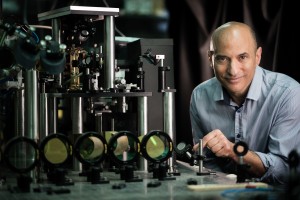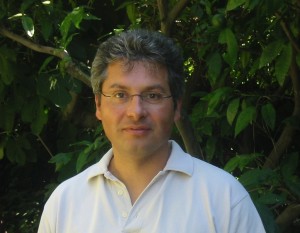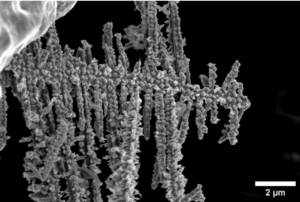Technion (Israël) : la théorie de Hawking prouvée grâce à l'analogue acoustique d'un trou noir. Commentaire du Dr Elbaz du CEA.

[:fr]
Des scientifiques du Technion en Israël ont pu prouver la théorie avancée en 1974 par Stephen Hawking selon laquelle les trous noirs dus aux effets quantiques peuvent émettre un rayonnement thermique. Jeff Steinhauer, professeur de physique au Technion, affirme ainsi avoir montré la théorie de Stephen Hawking sur les trous noirs. Le scientifique a créé «l’analogue acoustique» d’un trou noir en laboratoire et a confirmé que les objets spatiaux émettaient des flux de particules chargées, c’est-à-dire un rayonnement thermique. Cet analogue créé est un condensat de Bose-Einstein, en termes simples, un état de la matière composé de gaz et de particules qui sont refroidis à un zéro presque absolu (-273,15 C).

Les scientifiques ont conclu que les «analogues acoustiques»* sont très proches des modèles théoriques impliquant la présence du rayonnement de Hawking… L’équipe de Jeff Steinhauer (avec Juan Ramón Muñoz de Nova, Katrine Golubkov, Victor I. Kolobov) souhaite à présent mener l’étude à une échelle beaucoup plus grande.
Publication dans Nature, 29 mai 2019
Source sputniknews
* Trous noirs acoustiques : la propagation du son dans un fluide en mouvement étant analogue à celle de la lumière dans un espace-temps courbe, les physiciens conçoivent des «trous noirs acoustiques» aux propriétés semblables à celles des trous noirs (source Pour la Science).
———————————————
Le Dr David ELbaz*, directeur de recherche au CEA, membre du comité scientifique d’Israël Science Info, commente les travaux du Prof Steinhauer et de son équipe au Technion :

« En 1972, John Wheeler, le physicien qui donna leur nom aux trous noirs, réalisa que les trous noirs semblaient violer l’un des plus solides principes de la physique, le second principe de la thermodynamique. Un principe sur lequel les scientifiques s’appuient pour donner un sens à la fameuse flèche du temps. Le fait que le temps évolue du passé vers le futur nous semble une évidence mais reste énigmatique à l’échelle des particules élémentaires. Selon le second principe, une propriété que l’on peut associer à un ensemble de particules ne peut qu’augmenter. Cette propriété, l’entropie, caractérise entres autres le nombre d’arrangements que peut prendre cet ensemble de particules. Si je jette un verre par terre, il se brise en plusieurs morceaux étalés de manière aléatoire sur le sol. Il est très peu probable que si je ramassais ces morceaux de verre et que je les lançais en l’air ils retomberaient de sorte à reformer le verre initial. L’entropie du verre brisé est plus grande que celle du verre entier, le verre respecte donc bien le second principe.
Imaginons qu’un trou noir se trouve tout près de moi et qu’au lieu de retomber par terre, les morceaux de verre tombaient dans le trou noir, que se passerait-il ? Si, comme on le pensait alors, ce qui entre dans un trou noir disparait à tout jamais, alors le second principe serait violé car l’entropie associée aux morceaux de verre ayant disparue avec les morceaux de verre dans le trou noir, ce qui reviendrait à provoquer une perte d’entropie. Or l’entropie ne peut pas diminuer mais uniquement augmenter. Voilà ce qui choqua John Wheeler qui soumit le problème à son étudiant Jacob Bekenstein. Quelques mois plus tard, Bekenstein revint avec la solution du problème : l’entropie des morceaux de verre n’a pas disparue. La masse du trou noir augmente quand de la matière s’effondre dedans. Comme le rayon d’un trou noir (son horizon ou rayon de Schwarzschild), augmente avec sa masse, la surface du trou noir a aussi augmenté. Cette surface, cet horizon possède une épaisseur qui ne peut être absolument nulle car la mécanique quantique l’interdit. Cette peau quantique du trou noir doit non seulement présenter une épaisseur, mais aussi une granularité et c’est le nombre de grains de surface du trou noir qui représentent son entropie. Si on suppose que leur nombre est bien ajusté, l’augmentation de surface d’un trou noir associée à la chute des morceaux de verre devrait comptabiliser autant d’arrangements possibles de ces grains qu’il avait d’arrangements possibles des morceaux de verre.
Cette idée fut ensuite reprise par Stephen Hawking avec une implication inévitable dès lors que l’on introduit des propriétés thermodynamiques, comme le nom de cette science l’indique : l’apparition d’une température et donc aussi d’un rayonnement, le fameux rayonnement de Hawking. Dès lors, les trous noirs devenaient des sources de rayonnement. Ce rayonnement n’a encore jamais été détecté dans l’univers, mais de nombreuses études proposent de réaliser en laboratoire des systèmes analogues à la surface d’un trou noir, qui définit un horizon séparant deux zones qui ne peuvent communiquer entre elles.
Le Technion a montré pour la première fois que de l’énergie s’échappe de cet horizon
L’étude publiée dans Nature par de Nova, Goblukov, Kolobov et Jeff Steinhauer utilise un fluide composé d’atomes ultra-froids pour engendrer un telle séparation reproduisant les propriétés de l’horizon d’un trou noir. L’écoulement de ce fluide définit le sens de l’attraction du trou noir et les ondes qui se propagent à la surface du fluide constituent l’analogue de l’énergie qui tente de franchir l’horizon en remontant le courant. Au-delà de cette réalisation, ils ont réussi pour la première fois à montrer que de l’énergie s’échappe de cet horizon par un processus analogue à celui prédit par le mécanisme de Wheeler-Bekenstein-Hawking, mais aussi qu’il se comporte comme on l’attendrait dans le cas de l’émission d’un rayonnement associé à la température de Hawking. Une nouvelle étape vient donc d’être franchie dans la validation de ce phénomène contre-intuitif, l’évaporation des trous noirs. Il ne s’agit ici que d’un système analogue aux trous noirs, donc d’une analogie, mais elle présente cependant un autre intérêt car le mécanisme par lequel de l’énergie et donc de la masse est extraite fait appel à l’absorption d’énergie négative, c’est ce que l’on pense qu’il se passe aussi dans le cas du trou noir. Il peut sembler étrange de parler d’énergie négative, mais souvenons-nous que l’énergie gravitationnelle que l’on subit au quotidien puisqu’elle nous cloue au sol est elle aussi négative ».
*David Elbaz, astrophysicien, est directeur de recherche au Commissariat à l’Energie Atomique (CEA Saclay) où il dirige le laboratoire Cosmologie et Evolution des Galaxies. Il est conseiller scientifique auprès de l’agence spatiale européenne pour la sélection de ses futures missions spatiales (ESA, AWG) et membre du Comité d’évaluation sur la recherche et l’exploration spatiales pour le centre national d’étude spatiales (CNES). Spécialisé dans l’étude de la formation des galaxies, David Elbaz est auteur/co-auteur de 261 publications dont 70 avec plus de 100 citations. Ses travaux sur la formation des galaxies ont été primés par le Prix Chrétien de la Société Américaine d’Astronomie (2000), il a reçu le prix Jaffé 2017 de l’Institut de France. Il enseigne un cours sur la formation des galaxies au master M2 Astronomie & d’Astrophysique de Paris. Il a reçu le Prix du livre Science & Philosophie 2017 de l’association X-Philo de l’école Polytechnique. Il a publié « A la recherche de l’univers invisible : matière noire, énergie noire, trous noirs », en 2016 aux Editions Odile Jacob.
[:en]
During his distinguished career as a theoretical physicist and cosmologist, the late Stephen Hawking predicted that black holes – invisible and massive phenomena in space with such strong gravity that nothing, even light, can escape its deep, dark grasp – emit radiation. This Hawking radiation should have a thermal spectrum, similar to the radiation from any warm object. The temperature of the Hawking radiation should agree with the temperature predicted by astrophysicist Jacob Bekenstein.
Now, a team of researchers from the Department of Physics at the Technion–Israel Institute of Technology have modeled an artificial black hole and, by devising a way to measure the spectrum of Hawking radiation, have found that black holes do emit radiation like an ordinary warm object, as Hawking’s predictions asserted.
Almost four decades ago, a theory emerged suggesting black holes could be artificially constructed and used to measure the physics of Hawking radiation, a type of thermal radiation, the existence of which Hawking predicted in the 1970s and which now bears his name. However, it was the task of creating an artificial black hole, and devising ways to measure the spectrum of Hawking radiation and its temperature, that led to the recent breakthrough.

“Our artificially-constructed black hole provides confirmation of the thermality of Hawking radiation,” explained lead researcher Professor Jeff Steinhauer. “In addition, we found that the temperature is determined by the artificial gravity at the surface of the artificial black hole, also consistent with Hawking’s predictions.”
The success of their work is yet another profound insight into the nature of black holes, among the most mysterious and least understood secrets of the universe.
The concept of an object in space with gravitation fields too strong for light to escape were considered in the 18th century. The first modern theory about the existence of black holes was developed in 1916, but not fully characterized and considered to be just mathematical curiosities until the late 1960s, when theories were sparked by knowledge about the collapse of massive stars. Although they could not be seen, consensus was soon reached that black holes existed in most galaxies.
Having studied this phenomenon and problem for a decade, the research team made constant improvements to their experimental tools over the last three years. The goal was to not only create artificial black holes, but also to develop methods to make measurements to check Hawking’s predictions. To reach their conclusions, the Hawking radiation experiment was repeated 7,400 times, providing a density profile for each “run” from which the researchers computed averages.
“Theoretical works, combined with our long-term study of this subject, allowed for the observation of spontaneous Hawking radiation in a black hole,” reported Steinhauer. “The improvements in our experimental apparatus allowed us to measure the thermality of the Hawking spectrum and compare its temperature with Hawking’s prediction, given by the surface gravity.”
According to the researchers, that temperature, as predicted, provides an interesting link between the theories of Hawking and those of astrophysicist Jacob Bekenstein. In 1972, Bekenstein also presented a theory on black hole thermodynamics.
“Remarkably, although their calculations were based on very different ideas, both Hawking and Bekenstein came up with the same conclusion that the temperature was determined by the gravity at the surface of the black hole,” said Steinhauer. “We confirmed their predictions.”
The discovery made by the Technion physicists makes clearer the nature of black holes by measuring the spectrum emitted, very similar to the spectrum that would be emitted by an ordinary warm object. The low levels of radiation not only confirm Hawking’s theory, but could also lead to further research.
According to Steinhauer and his team, their findings provide not only hints about the nature of real black holes, but also about the “information paradox.” According to Hawking, the radiation and its thermal spectrum contain very little information. This idea is the basis of the information paradox, which poses questions such as: What is the fate of information that falls into a real black hole? Does it disappear from the universe? And, if not, where does it go?
The researchers found that the spectrum of the Hawking radiation is indeed thermal. So, the information paradox remains unresolved, with future researchers needing to look elsewhere to investigate the information paradox enigma.
Publication in Nature, May 29th 2019
[:]







